
Department of Civil and Environmental Engineering The Grainger College of Engineering University of Illinois Urbana-Champaign Summer 2024 CEE Department updates Alumni news and features


The CEE magazine is published twice a year for alumni and friends of the Department of Civil and Environmental Engineering at the University of Illinois Urbana-Champaign. Those who donate regularly receive every issue.
Ana P. Barros, NAE Donald Biggar Willett Chair of Engineering and Head
Celeste Bock Senior Director of Advancement Operations
Steven Hall Director of Advancement (217) 300-7830
stevhall@illinois.edu
Keely K. Ashman Assistant Director of Alumni and Corporate Relations kashman@illinois.edu
Olivia Grubisich Communications Specialist odg2@illinois.edu
CEE Magazine Department of Civil and Environmental Engineering
The Grainger College of Engineering
University of Illinois Urbana-Champaign 1201 Newmark Civil Engineering Laboratory MC-250 205 North Mathews Avenue Urbana, Illinois 61801
cee.illinois.edu
Cover: “Pioneers, Innovators and Visionaries” by artist Shan Shan Sheng, the installation in the first-floor hallway of the Civil and Environmental Engineering Building. The work depicts major projects and innovations of alumni and faculty of CEE at Illinois.
CEE M.S. program ranked #1 for 5 years running! Find out why U.S. News & World Report has ranked CEE’s program #1 among Best Online Master’s in Civil Engineering Programs since their online program rankings began! Contact us: Meg C. Griffin, P.E. Assistant Director for Graduate Programs mgriffn@illinois.edu General program questions: Email: ceeonline@illinois.edu Phone: (217) 333-3921 CEE Online 1

Alumni Awards: Dai, Knappe, Lopez and Sehgal honored Faculty profile: Billie F. Spencer Jr.

Legacy phosphorus delays water quality improvements in Gulf of Mexico
Flood prediction tool deployed in Great Smoky National Park
New material changes behavior depending on temperature

Tessum CAREER award: environmental equity of decarbonization
Global Leaders visit Vietnam Center for Secure Water established


Civil and Environmental Engineering Alumni Association—Summer 2024 3 5 6 8 10 16 18 20 21 22 23 24 25 26 27 28 30 32 34 36 39 40 43 Strengthening our industry ties/Ana Barros
CEE Alumni Association Update/Dana Mehlman
Stillwell
Flexible
to
Team to use hyperspectral remote sensing to study permafrost Genetic sequencing uncovers pathogens in floodwaters
to lead research for tiny home community 2023 Turkey earthquake holds lessons for the future
biosensors
combat worker heat stress Lehe CAREER award: public transportation pricing
Awards THE Conference celebrates
Department News In Memoriam Alumni News: Spellmon, Baker honored Parting Shot: Decoding Concrete’s Micro-World
16 22 41 10
Student
110th year
CEE
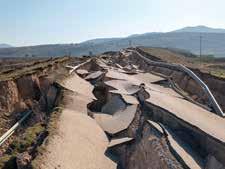
Check out these and other stories at
A multi-institution team including CEE Associate Professor Ahmed Elbanna will develop a new science gateway for the community of researchers who study earthquake forecasting, thanks to a five-year, $2.5 million grant from the National Science Foundation.
u CEE.ILLINOIS.EDU/NEWS
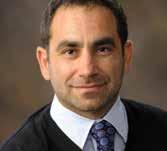
uAssistant Professor Houtan Jebelli will lead a study into the integration of exoskeletons – advanced wearable robots – focused on reducing workrelated injuries among construction workers. u

Researchers including Professor Oscar Lopez-Pamies have established a new protocol for deducing the tensile strength of a material in the commonly used Brazilian fracture test. The work has broad implications, including a current project to improve the treatment of kidney stones.
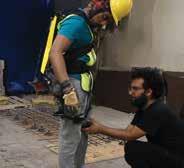

uA new project promises to improve health and safety for construction workers through wearable electronics. istockphoto.com/zog
CEEAA Board of Directors
President
David L. Byrd, P.E. (BS 01, MS 06)
Kenilworth, Ill.
Vice President
Dana B. Mehlman, P.E. (BS 99, MS 01)
Vedder Price PC Chicago
Second Vice President and Secretary
Daniel J. Whalen, P.E. (BS 84, MS 85)
Hanson Professional Services Inc.
Springfield, Ill.
Past President
Paula C. Pienton, P.E., S.E. (BS 85)
CN
Homewood, Ill.
Directors
Cleveland, Ohio istockphoto.com/yasharu
Ama O. Addai, P.E., (BS 04)
Ardmore Roderick Chicago
Jackie A. Becker, P.E. (BS 07)
Ameren Transmission
St. Louis, Mo.
Kimberly Cummins, P.E. (BS 98)
Cummins Engineering Corporation
Springfield, Ill.
Kevin C. Fuhr, P.E. (BS 96)
Hanson Professional Services Chicago
Brian S. Heil, P.E., (BS 96, MS 97)
Oates Associates Inc.
Collinsville, Ill.
Matthew A. Johnson, P.E., S.E. (BS 04, MS 08)
Fehr Graham Champaign
Kurt A. Keifer, P.E. (BS 97, MS 99, PhD 06)
IMS Infrastructure Management Services
Tempe, Ariz.
Justin R. Lewis, P.E. (BS 07, MS 08)
Keller North America Chicago
Michael J. Mack, P.E. (BS 89)
Burns & McDonnell
Downer’s Grove, Ill.
Andrew J. Martin, P.E. (BS 98)
Greeley and Hansen LLC Chicago
Douglas S. Pelletier (BS 95)
Burns & McDonnell Chicago
Katherine Pripusich-Sienkiewicz (BS 03, MS 13)
Amazon Web Services Chicago
Robert Risser (BS 87, MS89)
Precast/Prestressed Concrete Institute Chicago
Richard Sieracki (BS 74)
The Kenrich Group LLC Chicago
Michael Vitale, P.E. (BS 82, MS 84)
Mott MacDonald
4
cee.illinois.edu u
Strengthening our industry ties
 By AnA BArros, nAE
DonAlD BiggAr WillE tt ChAir in EnginEEring AnD hEAD
By AnA BArros, nAE
DonAlD BiggAr WillE tt ChAir in EnginEEring AnD hEAD
Dear Alumni and Friends of CEE,
As I write this, the weather has warmed up, leaves are developing on the trees all over campus, and we are finishing another successful academic year. The department is stronger than ever, and this year will bring some exciting new developments.
Our new undergraduate program has launched for the Bachelor of Science Degree in Environmental Engineering. Current students have been able to apply to transfer into the program since last year, and this fall we will welcome our inaugural class of first-year students. We were delighted with the large number of applications and the quality of the students interested in this track.
For the second year in a row, our CEE Alumni Association Board of Directors is helping us encourage admitted students to accept their offers of admission by making personal phone calls, sharing information about the department and answering any questions applicants might have. A big thank you to the Board for this effort; we are confident it will make a difference. This fall’s incoming class promises to be a diverse group of top-tier individuals, and we cannot wait to meet them!
As you may have heard, we have created a new Industry Partners Program (IPP) to strengthen our ties to industry. We believe this program will
benefit both our students and the participating firms. Companies are invited to sponsor the department at whatever level they are able, enjoying benefits including increased access to students, staff and faculty; increased visibility on campus; complimentary space at the CEE Career Fair; facilitated access to student groups and faculty; branding presence on our marketing platforms; assistance organizing campus and company visits; and email communication opportunities.
For companies, IPP sponsorship provides very distinct advantages. For example, companies who are building or expanding their talent pools might benefit from the increased recruiting opportunities that come with industry sponsorship. For the department, the benefits of this program will be critical to maintaining our excellence. Presently, corporate gifts come in the form of conference fees, research funding, facilities support, specific programs, and scholarship and fellowship gifts. We deeply appreciate this targeted funding. In addition, however, we have an increasing need for unrestricted funds to strengthen student classroom and laboratory experiences, provide training and professional development, and support student organizations. We are particularly excited about developing collabora-
tions whereby our students can work with faculty and industry mentors via independent study and internships toward developing specialized competencies needed to meet emerging technical needs. We launched a Cornerstone sponsorship program this fall to enhance our ability to bring technology innovations to the classroom in our first-year, project-based course that is our students’ introduction to engineering thinking. We look forward to collaborating with our alumni, the CEE Alumni Association Board, and industry partners in further refining and strengthening these initiatives.
Many of our peer institutions already have robust industry partners programs, making our initiative even more critical to maintaining our leadership position in civil and environmental engineering education. For more information about the IPP, please visit the CEE website.
Another new initiative is the re-establishment of CEE’s External Advisory Board (EAB). In the short term, the EAB will help us meet the requirements of the Accreditation Board for Engineering and Technology (ABET). Additionally, we will look to the EAB to help us anticipate and plan for changes in the civil and environmental engineering enterprises in the next 10 years: how we can best Continued on the next page
Civil and Environmental Engineering Alumni Association—Summer 2024 5
Strengthening our industry ties
Continued from the previous page
prepare our students as we approach the mid-century; how to harness AI and high-performance computing capabilities in the context of civil and environmental engineering; how to manage and mitigate nonstationary climate risk through resilient infrastructure; how to integrate across engineering disciplines; and much more. For civil and environmental engineers, considerations around these topics come with challenges; civil and environmental engineering is tightly linked to the regulatory environment, policy, economics, land-use planning and evolving societal needs. We are looking to our new External Advisory Board to provide critical guidance and inspiration for this important work.
Even as one school year ends, we in the department are always planning for the next one, and the ones beyond that. We are privileged to attract outstanding students to CEE. We must keep our eyes on the future –growing, evolving and anticipating the knowledge and experience our students will need as they graduate and become our future practitioners and industry leaders. I know we can continue to count on you, our alumni and industry supporters, to help us do just that.
Go Illini! i
CEEAA update
 By DAnA B. MEhlMAn (BS 99, MS 01) PrEsiDEnt-ElEC t, CEE AluMni AssoCiAtion BoArD of DirEC tors
By DAnA B. MEhlMAn (BS 99, MS 01) PrEsiDEnt-ElEC t, CEE AluMni AssoCiAtion BoArD of DirEC tors
I officially assume role of President of your Civil and Environmental Engineering Alumni Association (CEEAA) Board of Directors this September, and I am thrilled, honored and humbled to hold this position. My journey with the CEEAA began over a decade ago, in 2012, under rather inauspicious circumstances.
After graduating from the University of Illinois with my B.S. (environmental concentration) and M.S. (geotech concentration), I spent just shy of a decade in Atlanta practicing as a self-titled geoenvironmental engineer. In Atlanta, I had the honor of serving as President of the Atlanta Illini – the local alumni chapter – for four years. Although Atlanta was not home, I found home in the friends I made through the club and a common connection to the University of Illinois.
In 2007, I decided to go back to school. Newly graduated with a shiny law degree and a certificate in environmental and land use law, I was ready to set the world on fire – only to find that in 2010, the world was at more of a standstill. While job searching, I also spent quite a bit of time soul searching. I fondly recalled the university connections I had made in Atlanta and decided to apply for an open position with the CEEAA. The rest, as they say, is history.
The CEEAA has evolved over the past 12 years, I believe, for the better. We have members representing diverse CEE concentration areas; diverse geographi-
cal regions; diverse backgrounds; and diverse career paths and goals. We work hard to ensure that various perspectives are represented so that we can provide you, our alumni, the best alumni experiences as well as exemplary interactions and experiences for the department’s students, faculty and staff.
We currently have 15 members and an executive committee of four members. The 19 of us serve on four committees: the alumni-faculty interaction committee, the alumni interaction committee, the student support committee, and the award/nominating committee. In addition, we have a Young Engineers Division, focusing on the needs of graduates under the age of 35.
Our alumni-faculty interaction committee hosts two faculty research seminars each year, one in the spring and one in the fall. These seminars are provided via web interface and offer professional development hours for all attendees. This is one way for all alumni, near and far, to stay connected and updated on faculty research. We also work hard to recognize our faculty when they win awards – a very frequent occurrence –with letters of congratulations.
The alumni interaction committee works hard to plan and execute events for you, our alumni. This year we plan to hold socials in both St. Louis and Chicago. Our annual golf outing will once again take place at Ruffled Feathers Golf Club in Lemont, Ill. We are also bring-
6
cee.illinois.edu
6 cee.illinois.edu
New major!
ing back one of our more recent and popular events this fall, the CEE tailgate – open to students, faculty, staff, alumni and friends. Information on all of our events and links for registration can be found here: cee.illinois. edu/alumni/events.
Our student support committee is busy in the fall and spring semesters with the (now famous among students and recent graduates) Backpack to Briefcase (B2B) series which explores topics such as: student organizations, resume writing, the interview process, negotiating job offers, career development and workplace expectations.
We are able to accomplish so much because we represent the best department in the College of Engineering. Many thanks to my predecessors, David Byrd, who will be transitioning to the role of immediate past president, and Paula Pienton, who is completing her term after serving on the CEEAA board for the past 16 years.
The CEEAA is here for you. We want to hear from you. For those of you who are involved in the department and university, thank you for your support, I hope you stay involved. For those who are not yet involved, please reach out, as we are always looking for new ways to engage additional alumni.
Go Illini! ��������

Bachelor of Science in Environmental Engineering
Students will:
Learn the skills to take on climate change and solve complex, evolving societal challenges
Choose an emphasis: environmental sustainability with energy, climate, water resources, public health, or clean water and sanitation
Engage in hands-on undergraduate research
Enter the rapidly growing job market for Environmental Engineers protecting communities and ecosystems

Civil and Environmental Engineering Alumni Association—Winter 2023 7 Civil and Environmental Engineering Alumni Association—Winter 2023 7
Alumni Awards Dinner 2024
CEE alumni gathered at the Union League Club in Chicago March 7, for the annual dinner celebrating the CEE Alumni Association awards. The event is open to all alumni and includes a cocktail hour for networking.



Peter
Distinguished Alumni Award
For distinguished leadership of major space and defense programs, and research contributing to structural engineering for spacecraft and protective construction. Dai was the first to develop a general computer program for structural analysis of spacecraft systems and developed advanced expandable structure concepts for the protection of spacecraft. He held leadership roles in support of U.S. national defense. Upon retirement, he became the Director of the National Space Program Office of Taiwan, where he initiated the ROCSAT satellite R&D. He established the Peter Dai Graduate Fellowship in the department and was a mentor to several civil and structural engineers in the areas of missile and space systems engineering.
Dai’s career included serving as a research engineer at the Air Force Materials Laboratory (1936-1965); joining TRW Systems to develop a general computer program for structural stress analysis of space systems; and serving as Deputy Program Manager for Peacekeeper (MX) Missile Basing. After retiring from TRW in 1992, he became Director of the Taiwan National Space Program.
Detlef R.U. Knappe (BS 89, MS 91, PhD 96)
Distinguished Alumni Award
For fundamental and applied contributions related to source water protection by identifying contaminants through targeted and non-targeted analyses, and on the development of treatment approaches for the remediation of regulated and unregulated contaminants. Knappe is an internationally recognized leading scholar whose work on drinking water quality and treatment has had tremendous impact on public awareness and protection of public health. Knappe’s research on emerging contaminants, such as PFAS, has reached town councils, drinking water providers, regulators and the public. His work has been covered by a number of national and international news services.
Knappe is the S. James Ellen Distinguished Professor of Civil, Construction and Environmental Engineering at NC State University. His research interests broadly encompass drinking water quality and treatment with the goal of reducing human exposure to organic contaminants. His research group has advanced fundamental understanding of activated carbon adsorption. His work on the occurrence of per- and polyfluoroalkyl substances (PFAS) and 1,4-dioxane has directly influenced state and national policy and led to substantial improvements in drinking water quality for more than a million North Carolinians.
8 cee.illinois.edu
CEE staff member Celeste Bock, left, receives the Distinguished Alumni Service Award from CEE Alumni Association President David Byrd. Bock retired in April after 22 years as editor of the CEE Magazine.
Paula Pienton (BS 85) was honored for 16 years of service on the CEE Alumni Association Board of Directors. Pienton was most recently Past President.
K. Dai (MS 60, PhD 63)
Avaristto “Jim” Lopez (BS97) Distinguished Alumni Award
Lopez’s career is an outstanding example of the realized potential provided by UIUC CEE training and an inspiration to future generations of alumni. He is a first-generation university student from a traditionally underrepresented demographic. Lopez has consistently demonstrated exceptional entrepreneurial vision. Under his leadership, Broeren Russo Builders has grown from a single company with annual revenues of $25 million to a family of companies with annual revenues exceeding $250 million. He hires and mentors UIUC CEE alumni, fosters a culture of community service, and is dedicated to his workers. Lopez models the mantra of “putting the client’s needs first.” His leadership has allowed Broeren Russo Builders to flourish in the Champaign County community as a builder you can trust. Lopez is CEO of Broeren Russo, which offers expertise in Design Build, Construction Management, General Contracting, Consulting and AISC Steel. Lopez’s career has included service in the U.S. Army 682nd Engineer Battalion; and working on projects in the Champaign-Urbana area, including the area’s tallest building, nicknamed “The Whopper,” at 24 stories. Other notable projects Lopez has participated in include the iHotel, the Indoor Golf Building, Memorial Stadium additions, the Atkins Baseball Center, the Martin Softball Center, and the Ubben Basketball Complex.

Luv Sehgal (MS 17) Young Alumni Achievement Award
For his embodiment of the Outstanding Young Alumnus Award qualities – innovation, leadership, service and the capacity to inspire positive change. Sehgal’s career is marked by rapid advancement, leadership in rail systems and a commitment to engineering excellence and sustainability. He has consistently delivered outstanding results at Arup and TY Lin, exceeding goals and consistently performing at a level that stands out from the team. His demonstrated expertise of trackwork skills significantly contributes to project success. Sehgal is dedicated to UIUC and AREMA, and he actively engages with student chapters, mentoring and workshops. He is a rare gem in the field of civil engineering,
embodying the spirit of relentless pursuit of excellence.
Sehgal is a Senior Engineer at Arup, based in Toronto. His research involves sustainable track design, high-speed rail infrastructure, and resilience of transit systems. He has worked on diverse infrastructure projects across New York, Boston and Toronto, collaborating on initiatives for multiple agencies in capacities such as Designer, PM/CM, Technical Adviser and Owner’s Representative. His commitment to innovation, focus on sustainability and technical excellence underscore his dedication to public transportation solutions that spur economic growth and promote social equity and inclusion.
Civil and Environmental Engineering Alumni Association—Summer 2024 9
Award winners (from left) Detlef Knappe, Luv Sehgal and Avaristto “Jim” Lopez. Peter Dai was unable to attend the dinner.
Faculty profile:
Bill
Spencer
Throughout his career, this internationally recognized expert in smart structures technology has encouraged students of all ages to take a hands-on approach to engineering innovation
As a teenager growing up in southern Illinois, Billie F. Spencer Jr. learned to work on cars with his uncle, who owned a body shop.
“Every car I had until I graduated from college and got my first job was a salvage car,” he says. “There was one particular car – a Volkswagen Scirocco. The front end was a 1978 model with fuel injection, the rear end was a 1976 model with a carburetor, and the interior wiring and air conditioning were from a 1977 model. You could call it my Frankencar.”
This same resourceful spirit has characterized Spencer’s nearly 40year career in academia. Today, Spencer is the Nathan M. and Anne M. Newmark Endowed Chair in Civil Engineering at The Grainger College of Engineering, University of Illinois Urbana-Champaign. He is a member of the Chinese Academy of Engineering (he is fluent in Mandarin), the Japanese Academy of Engineering, and the Polish Academy of Sciences, and a Distinguished Member of the American Society of Civil Engineers. Among his many awards is the 2018 ASCE Newmark Medal, given “for pioneering work, innovations and leadership in the theory and application of advanced technologies to
fundamental problems in structural engineering and mechanics, as well as for his unwavering commitment to education/mentoring of students and professional service.” He is an internationally recognized expert in smart structures technology, a field in which he has invented and built such innovations as wireless sensor sys-
hands dirty. It’s not available? OK, let’s make it.”
This is a signature of our work: we’re not afraid to
get our hands dirty. It’s not available? OK, let’s make it.
“ ”
tems for infrastructure health monitoring, smart dampers using magnetorheological fluids for protection of civil engineering structures during earthquakes, and custom drones for structural health inspection.
“This is a signature of our work,” he says. “We’re not afraid to get our
Spencer grew up in Roxana, Ill., where in high school he participated on the wrestling team, called the Roxana Shells after the Shell Oil Company Refinery in town. He and his brother were raised by his father, a printer for the St. Louis Post Dispatch newspaper, and his grandmother, who worked at a garment factory. They lived in a small, two-bedroom house, so Spencer shared a room with his father and brother.
“We weren’t poor, but we weren’t rich,” he says. “We never wanted for anything, but we always did things ourselves. You repaired your own car, lawnmower, TV. It was very much a blue-collar family.”
No one in Spencer’s family had gone to college, and the guidance counselors at his high school “were primarily there to help you graduate, not to help you go to college afterwards,” he says. Nevertheless, as high school graduation approached, Spencer applied to The University of Missouri – Rolla (now the Missouri University of Science and Technol-
Continued on page 12
10 cee.illinois.edu
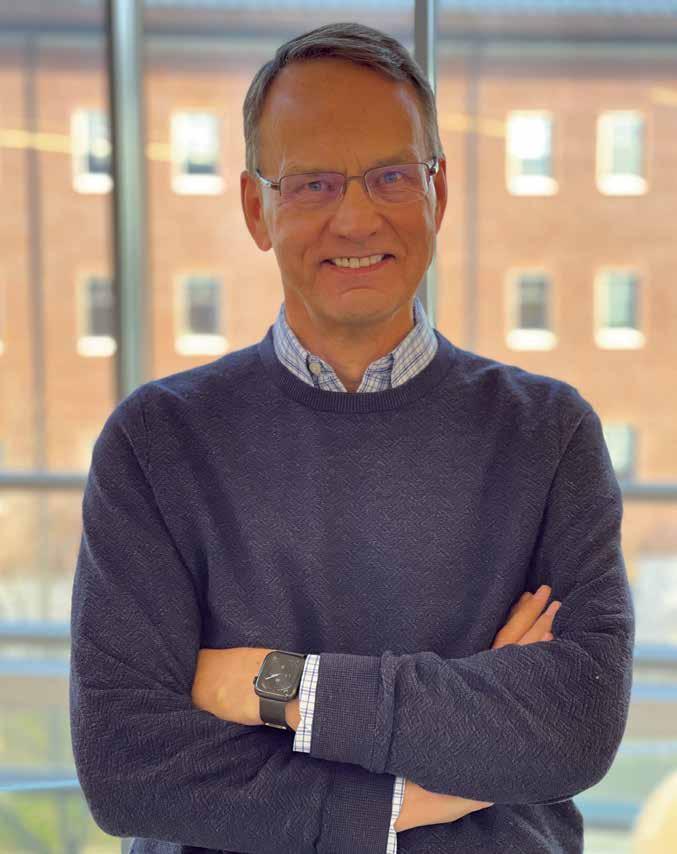
Civil and Environmental Engineering Alumni Association—Summer 2024 11
After a while, I guess I morphed from being a mechanical engineer into being a civil engineer.


Continued from page 10
ogy) and to the University of Illinois, and he was accepted at both. He chose Rolla partly because the wrestling program there was Division II (Illinois was Division I), so he would be able to be on the team. He qualified for Nationals, and to this day, he still holds most of the school’s wrestling records. He majored in mechanical engineering; it seemed like a good fit because of his hobby of working on cars. During his undergraduate summers, he interned at General Motors in Warren, Mich., working in their structural engineering research group in the noise and vibration laboratory.
It was during his undergraduate years that Spencer first considered research as a career. He had planned to stay a semester longer than most of his friends so he could continue to wrestle, but as graduation approached, he changed his mind. He needed a few more credits, so a professor in social sciences enrolled him in an independent study class to research the frequency of baseball batters getting hit with balls in the American League versus the National League. He had to compile statistics from issues of the Sporting News, available in the St. Louis Public Library. When he completed the project, the professor complimented his work and asked if he had ever considered getting a Ph.D.
“The answer was no,” Spencer says. “But that was the spark of it there.”
Spencer first came to the University of Illinois as a master’s student in the Department of Theoretical and
Applied Mechanics (TAM), following his interest in vibration engineering. At General Motors, he had studied vibration engineering in mechanical systems, but as a graduate student he expanded his focus to include random vibration that occurred as a result of earthquake, wind and wave loading. He took courses in TAM but also in Civil Engineering and Electrical Engineering. His mentor, Illinois Professor Larry Bergman, encouraged him to pursue a Ph.D., pointing out that many of Spencer’s non-academic interests were engineeringrelated.
“He said my hobby could be my work, and how much better can it get than that?” Spencer says.
In addition, the teaching aspect of an academic career was appealing. As an undergraduate, Spencer had taught drafting to electrical engineers, work that he had found rewarding. During graduate school at Illinois, he also served as “a fullfledged instructor,” teaching sophomore statics, dynamics and mechanics of solids to classes of 40-100 students during five of his semesters and even winning a teaching award from the TAM department.
Because of the breadth of his coursework and experience at Illinois, Spencer found a receptive job market when he began looking for academic positions. He had interest from departments in mechanical engineering, aerospace engineering and civil engineering.
“This area of work that I did was kind of agnostic,” he says.
Spencer joined the faculty of the
12 cee.illinois.edu
Spencer with his mother and father at his Ph.D. graduation ceremony in Champaign.
Spencer with his grandmother at UIUC Ph.D. graduation ceremony in Champaign.
“ ”
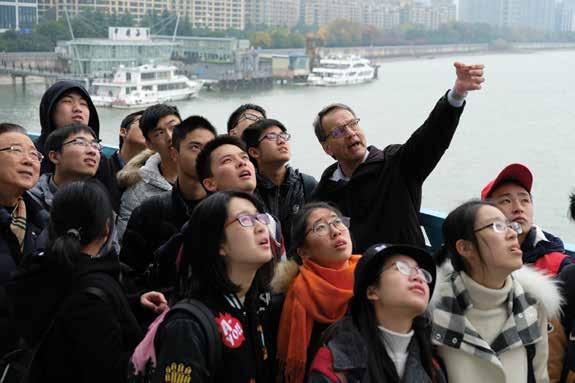
Department of Civil and Environmental Engineering at the University of Notre Dame in 1985. Over the next seventeen years he taught courses in mathematics, statics, dynamics, mechanics of solids, structural reliability and probability.
“After a while, I guess I morphed from being a mechanical engineer into being a civil engineer,” he says.
In 2002, Spencer returned to Illinois as a member of the CEE faculty, where he has taught graduate and undergraduate courses in structural mechanics, structural dynamics and random vibration. His work in smart structures technology has been groundbreaking. In a joint project with Illinois Computer Science Professor Gul Agha, Spencer led the development of an inexpensive, wireless means for continuous and reliable structural health monitoring. In 2009 the Illinois researchers collaborated with colleagues at KAIST in Korea and
the University of Tokyo to successfully deploy the system at full scale on the Jindo Bridge in South Korea. It was the first dense deployment of a wireless sensor network on a cablestayed bridge and the largest of its kind for civil infrastructure to date. The researchers designed, developed and tested sensors that could be manufactured very cheaply and still produce the high-fidelity data required for structural health monitoring. Their research also produced a customizable software framework that simplified the development of structural health monitoring applications for smart sensor platforms. Since then, Spencer’s group has deployed wireless smart sensors on a number of automobile and railroad bridges.
In 2015, Spencer’s group developed and deployed an even larger wireless monitoring system for the world’s biggest Ferris wheel being
We have a model of a structure that is of interest to us, If an earthquake occurs, we can run a simulation in the digital twin and then send the drone out to look at the relevant portions.
Civil and Environmental Engineering Alumni Association—Summer 2024 13
Spencer leads a field trip to the 4th Qianjiang River Bridge Bridge in Hangzhou with students from Zeijiang University and UIUC.
“ ”


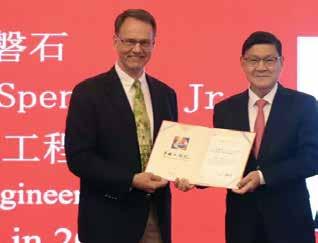
“
Our idea is that you’ve got an army of drones that are ready to be deployed and do that initial inspection to help people to return more quickly to their lives and businesses,
”
constructed in Dubai. The tension of the wheel’s 192 cables needed to be monitored, particularly in the construction phase. A special concern was Dubai’s intense heat. The wireless sensors were powered by lithium-ion batteries, which could catch fire if they heated up too much during the charging stage. To prevent that, Spencer’s team developed a special circuit that would shut off the charging if the temperature became too high. The system worked in sync with the climate, charging the batteries in the cooler morning and evening hours.
Another area in which Spencer has taken an innovative approach is in the use of drones for structural inspections. In a project for the U.S. Army Corps of Engineers, he led the development of a specially designed drone to perform automated inspections of the lock gates on dams. The high walls on the lock chamber result in a GPS-denied environment, so drones can’t navigate using satellite signals. With no readily available platform that allowed a drone to operate without GPS, Spencer had to invent one.
“There’s a 3D-depth camera on the front and a mini-computer on the back, so it can take in the information, process it using machine learning and then send it to a controller that will cause the drone to execute
whatever mission is needed,” Spencer says.
Because ready-made drones operate with proprietary computer systems, Spencer had to buy a drone he could assemble and program himself. He bought two, built the first one to learn how to do it, and then he had his students build the second. Their testbed is the cul-de-sac between Newmark Lab and the new Civil and Environmental Engineering Building, where the height of the buildings also hampers GPS signals.
Spencer’s newest project is developing what he calls a “soup to nuts” approach for structural health inspection. After an earthquake or other widespread disaster, the system will send out drones to take photos of important infrastructure using computer vision and machine learning to help assess the condition of structures. The idea is to multiply the efforts of first-responding engineers and get critical infrastructure back in use as soon as possible. He is motivated by the lesson of the 311 earthquake in Japan on March 11, 2011, when infrastructure was crippled after the earthquake and resulting tsunami damaged homes, businesses, roads and railways. In such disasters, Spencer says, there may be thousands of damaged structures and only hundreds of engineers to assess their condition.
14 cee.illinois.edu
Lecturing at conference in Bali, Indonesia (2016).
Induction as a Distinguished Member of ASCE in Chicago (October 2023).
Induction as a foreign member of the Chinese Academy of Engineering in Beijing (2023).
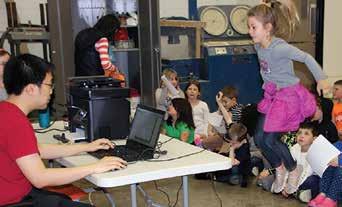
“Our idea is that you’ve got an army of drones that are ready to be deployed and do that initial inspection to help people to return more quickly to their lives and businesses,” Spencer says.
This army of drones would collect the images and analyze the structures’ condition by comparing the photos with a graphics-based digital twin, a 3D synthetic environment that combines a numerical model of the structures with photorealistic visual imagery.
“We have a model of a structure that is of interest to us,” Spencer says. “If an earthquake occurs, we can run a simulation in the digital twin and then send the drone out to look at the relevant portions.”
When it is complete, the system will be unique in the world, Spencer says.
Despite his long and growing list of research and technological innovations, Spencer views his students as his finest accomplishment. It is a fitting perspective, given the impact that encouragement from teachers has played in his own life. He has graduated nearly 40 Ph.D. students so far. After working with Spencer, many students have gone on to pursue careers in research and education themselves, taking positions at universities in the U.S., Taiwan, Japan, China, Korea and Ecuador.
He has inspired students internationally through programs he developed such as the Natural Hazard Mitigation in Japan initiative, which facilitated a summer study abroad for more than 100 students. His AsiaPacific-Europe Summer School on Smart Structures Technology has trained more than 600 students since its inception in 2008. It has been hosted twice at Illinois.
A K-12 outreach program he developed in 1998 called “Shakes & Quakes” teaches younger students about earthquakes and engineering and includes testing structures they build with Legos or K’Nex on a tabletop shake table. Over the past 25 years, Spencer and his graduate students have visited local schools to present the program, as well hosted crowds of pupils on campus.
“I can make a cool drone; somebody else will make a better drone. I can develop some algorithms; somebody is going to do better. But the students are going to go out and make their own, lifelong impact,” Spencer says. “We’ve written some good papers, done some good research, it’s gotten good visibility, but it’s the students who really make the job worthwhile. That’s really the product of our labor. I view the research as the tool by which we educate them to be the next generation of leaders in the field.” i

Discussions
It’s the students who really make the job worthwhile. I view the research as the tool by which we educate them to be the next generation of leaders in the field.

Civil and Environmental Engineering Alumni Association—Summer 2024 15
of drone inspection strategies with UIUC students.
“ ”
Working with Martha Cuenca on a wireless sensor board being developed in the Smart Structures Technology Lab at UIUC.
The Shakes and Quakes program being held in Newmark Laboratory for more than 200 first graders from Sangamon Elementary School in Mahomet, Ill.
Study: ‘Legacy’ phosphorus delays water quality improvements in Gulf of Mexico
By lois yoksouliAn
The same phosphorous that fertilizes the thriving agriculture of the Midwest is also responsible for a vast “dead zone” in the Gulf of Mexico near the Mississippi Delta. Efforts to reduce the amount of phosphorus that enters the Mississippi River system are underway, but research led by CEE Professor Ximing Cai suggests that remnants of the contaminant are left behind in riverbeds for years after introduction and pose an overlooked – and lingering – problem.
Phosphorus from wastewater and agricultural runoff flows downstream to the Gulf of Mexico, where it fertilizes plankton. As the plankton eventually die and decompose, the process depletes the Gulf’s water of oxygen – a condition called hypoxia – and creates a dead zone for sea creatures like fish and shrimp. The federal Gulf of Mexico Hypoxia Task Force aims to achieve a 25% reduction in phosphorus flows to the Gulf by 2025. This target relies on individual states to achieve a 25% reduction and assumes that those reductions will quickly lead to the desired outcome.
The study by Cai, CEE alumnus Kevin Wallington (MS 18, PhD 23) and University of Wisconsin-Madison professor Margaret Kalcic questions how remnants of phosphorus that entered the Mississippi River system in the past but remain buried in waterway sediments – called legacy phosphorus – may delay phospho -

rus reductions at the Gulf of Mexico, long after Midwest states have met their discharge-reduction goals. The findings are published in the journal Science of the Total Environment.
“Our watershed model simulates how phosphorus travels through rivers. But what makes our study different is that it also accounts for how phosphorus can interact with river beds at large spatial scales,” Cai said. “We capture the processes that cause phosphorus to repeatedly stop in
some river locations and start traveling downstream again at some point in the future. This process could result in long periods before old phosphorus can flush out of the river system, especially for large rivers.”
Using their model, the researchers investigated a hypothetical future where a wastewater treatment plant along the Sangamon River in Decatur, Ill., stops discharging phosphorus into the river.
“We chose Decatur because it is
16 cee.illinois.edu
A new study examines how phosphorus from agricultural runoff can become buried and re-released in the Mississippi River system, possibly delaying water quality improvement efforts in the Gulf of Mexico. Photo courtesy Lynn Betts
One of the primary goals of this study is to inform the public and regulators that even when states like Illinois meet their phosphorus remediation goals, it could be years, even decades, before the same results are seen in the Gulf.

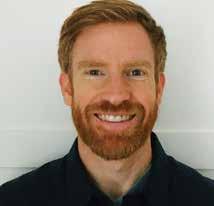
located in a very typical Midwestern agro-industrial watershed, making it an ideal case study for our model,” Wallington said. “Additionally, the location is actively exploring plans for large-scale phosphorus removal from its waste streams.”
The researchers found that it would take up to nine years for the Sangamon River to return to precontaminant, or baseline, phosphorus levels.
“Our model indicates that it takes much longer to recover at locations further downstream from the point of remediation,” Wallington said. “It would only take two to three years to recover at a location 5 kilometers downstream from the Decatur treatment plant, but it would take nine years to recover at a point 70 kilometers downstream. The Gulf of Mexico is 2,640 kilometers downstream, so the reductions there might lag far behind remediation efforts.”
However, the researchers acknowledge that their results, which only extend 70 kilometers down-
stream, cannot be directly extrapolated all the way to the Gulf of Mexico, and further research is needed at the scale of the entire Mississippi River basin.
“One of the primary goals of this study is to inform the public and
regulators that even when states like Illinois meet their phosphorus remediation goals, it could be years, even decades, before the same results are seen in the Gulf,” Cai said.
The National Science Foundation supported this research. i

Civil and Environmental Engineering Alumni Association—Summer 2024 17
This satellite image illustrates the extent of the oxygen-depleted dead zone in the Gulf of Mexico – a result of phosphate-containing agricultural runoff entering the Mississippi River system from Midwestern farms. Graphic courtesy NOAA
Ximing Cai
Kevin Wallington
Flood prediction tool prototype being deployed in Great Smoky Mountains National Park
By oliviA gruBisiCh
To improve flash flood response in the Appalachian region, researchers worked with Amazon Web Service (AWS) to prototype a hydrological prediction tool capable of providing the National Park Service flood hydrographs with 18-hour lead times.
Led by CEE Department Head Ana P. Barros, the project to develop the model is being made possible through cloud computational resources funding from the Amazon Sustainability Data Initiative. AWS will host the model, allowing easy access to large data sets necessary for prediction.
Researchers hope improved flood modeling will aid the staff of Great Smoky Mountains National Park in natural hazard planning, decisionmaking and fostering resiliency in areas vulnerable to flooding.
Flash floods occur in the Appalachian Mountains for two primary reasons. In mountain ranges, high elevation produces orographic enhancement, in which moist air masses are forced to rise, encouraging cloud formation and therefore increased precipitation. Additionally, the complex terrain and steep slopes make it difficult to store and contain the large amounts of water produced by rapid rainfall.
“In mountains, the watersheds or river basins near the ridges are organized like teacups on the landscape, and they’re very small teacups,” said
One cannot stop an earthquake from happening, cannot stop a big storm from coming through. However, we can take measures to ensure we anticipate and mitigate the consequences. This is the essence of resilience.
Barros. “So, if a precipitation cell sits on top of one of these teacups, very soon it will fill up.”
When heavy rain hits, the basins quickly become saturated. This forces ensuing rainfall into streams and leads to a flash flood response. Flash floods pose less of a public threat at higher elevations because these areas often contain less dense populations. However, lower elevation mountain ranges like the Appalachians are well populated, with large communities and national parks that receive thousands of daily visitors dispersed across the landscape. Knowing about potential floods far in advance is crucial to making deci-

Ana Barros
sions that protect those living in and visiting the area.
“The longer the lead time is, much more can be done in terms of preparing for flash flood events: issue warnings, evacuations, school closing, park closing, etc.,” said Mochi Liao, a post-doctoral researcher working with Barros on the development and distribution of their prediction tool, the Duke Coupled Hydrology Model (DCHM).
DCHM is a physically based, fully distributed hydrological prediction model capable of producing the advanced warning the National Park Service (NPS) needs. Its features include runoff, two-way streamflow routing, surface-subsurface interactions, multi-layer snow physics, variable soil depths, wetland physics, data assimilation, prognostic phenology and dynamic vegetation roots.
18 cee.illinois.edu

To run a prediction, DCHM requires weather, soil and landcover data input from the area of interest as well as weather forecasts.
For NPS, using a model like DCHM presents two challenges. First, they have to obtain the knowledge framework necessary to host and operate the model. Additionally, staff must deal with the time-consuming nature of finding, cleaning and clipping appropriate data to run a model prediction. Under the pressure of impending floods and heavy rain, clunky preparation procedures become an even greater hindrance.
The Amazon Sustainability Data Initiative (ASDI) resolves these issues by providing seamless data accessibility and integration between the data and modeling systems. ASDI supports research and innovation in sustainability by minimizing costs and time required to find and analyze large data sets related to sustainabil-
ity efforts. ASDI works with agencies like NOAA, NASA, the UK Meteorological Office and ESRI to collect and host key data sets produced by each group on AWS.
As a hub of sustainability information, AWS allows researchers and data scientists to easily find and utilize important data needed for projects targeted at improving global resilience. Connecting NPS with DCHM exemplifies this mission by enabling access to flash flood risk information long before the floods reach their peak.
Ultimately, it only takes DCHM 15 minutes to produce a flood forecast with an end-to-end maximum latency of 20 minutes. When input with high resolution rapid refreshing (HRRR) data from NOAA, which is available through AWS and provides real-time 3km resolution atmospheric data that refreshes every 15 minutes, DCHM can produce predictions
with 18-hour lead times. On six-hour intervals, it can even produce lead times up to 48 hours.
The key to improving natural hazard planning lies in providing decision makers with more time between receiving a forecast and the peak of the flood event. With the prototype forecast system made possible through support from AWS, the NPS is one step closer to increasing their overall flood response efficiency. Once implemented for operational use, Great Smoky Mountains National Park’s use of the new tool could set a precedent for flash flood planning and natural hazard resiliency across the entire Appalachian region.
“One cannot stop an earthquake from happening, cannot stop a big storm from coming through,” said Barros. “However, we can take measures to ensure we anticipate and mitigate the consequences. This is the essence of resilience.” i
Civil and Environmental Engineering Alumni Association—Summer 2024 19
istockphoto.com/wendyolsenphotography
Researchers are deploying a prototype flood prediction tool in Great Smoky Mountain National Park, shown in the stock photo above.
New material changes behavior depending on temperature
By lois yoksouliAn
Researchers report that they have developed a new composite material designed to change behaviors depending on temperature in order to perform specific tasks. These materials are poised to be part of the next generation of autonomous robotics that will interact with the environment.
The new study conducted by UIUC CEE Assistant Professor X. Shelly Zhang and graduate student Weichen Li, in collaboration with professor Tian Chen and graduate student Yue Wang from the University of Houston, uses computer algorithms, two distinct polymers and 3D printing to reverse engineer a material that expands and contracts in response to temperature change with or without human intervention.
The study findings are reported in the journal Science Advances in the paper, “Algorithmic encoding of adaptive responses in temperaturesensing multimaterial architectures.”
“Creating a material or device that will respond in specific ways depending on its environment is very challenging to conceptualize using human intuition alone – there are just so many design possibilities out there,” Zhang said. “So, instead, we decided to work with a computer algorithm to help us determine the best combination of materials and geometry.”
The team first used computer

modeling to conceptualize a twopolymer composite that can behave differently under various temperatures based on user input or autonomous sensing.
“For this study, we developed a material that can behave like soft rubber in low temperatures and as a stiff plastic in high temperatures,” Zhang said.
Once the team had fabricated the material into a tangible device, they tested its ability to respond to temperature changes in order to perform a simple task – switch on LED lights.
“Our study demonstrates that it is
possible to engineer a material with intelligent temperature sensing capabilities, and we envision this being very useful in robotics,” Zhang said. “For example, if a robot’s carrying capacity needs to change when the temperature changes, the material will ‘know’ to adapt its physical behavior to stop or perform a different task.”
Zhang said that one of the hallmarks of the study is the optimization process that helps the researchers interpolate the distribution and geometries of the two different polymer materials needed.
20 cee.illinois.edu
Researchers led by UIUC produced a new temperature-dependent, 3D-printed polymer composite that can react to its environment. Image courtesy of Weichen Li, Yue Wang, Tian Chen, Xiaojia Shelly Zhang and Science Advances.
We developed a material that can behave like soft rubber in low temperatures and as a stiff plastic in high temperatures.

“Our next goal is to use this technique to add another level of complexity to a material’s programmed or autonomous behavior, such as the ability to sense the velocity of some sort of impact from another object,” she said. “This will be critical for robotics materials to know how to respond to various hazards in the field.”
The National Science Foundation supported this research. i
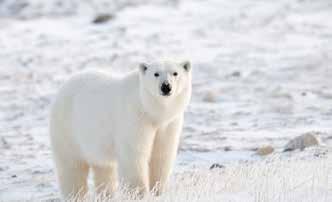
Team to use hyperspectral remote sensing to study permafrost
A multidisciplinary research team led by CEE Assistant Professor Tugce Baser will study the hyperspectral remote sensing of permafrost, thanks to a grant from the Department of Defense (DoD) as part of its Multidisciplinary University Research Initiative (MURI) program.
The project, called I’MSHARP for Interdisciplinary Material Science for the Hyperspectral Remote Sensing of Permafrost, will study multiphysical permafrost properties through newly developed, multi-scale theoretical and experimental tools via remote sensing, light polarization and electromagnetic theory. They will explore the fundamental physical, chemical, electromagnetic, thermodynamic, hydraulic and mechanical properties of permafrost under current and changing environmental conditions that govern the remote sensing of permafrost at various wavelengths.
“Frozen ground is a crucial element affecting the rate and magnitude of Earth’s global warming because it plays a critical role in our planet’s water, heat and carbon cycle,” Baser said. “The spatial heterogeneity, temporal variability, and extensive area of Earth’s permafrost pose an enormous challenge for developing a unified picture of the current state and the evolution of Earth’s cold regions.”
In addition to Baser, the team includes Go Iwahana of the Inter-

national Arctic Research Center at the University of Alaska Fairbanks; Michael Lanagan, The Pennsylvania State University; Joel Johnson, Ohio State University; Sahin Ozdemir, The Pennsylvania State University; and Vasit Sagan, Saint Louis University.
The highly competitive MURI grant program funds teams with diverse expertise and creative scientific approaches to address highly complex and cross-disciplinary science and engineering challenges.
“The knowledge gained will advance our understanding of surface scattering from heterogenous structures for design of high-resolution hyperspectral sensors for better characterization and prediction of changes in permafrost landscapes and addressing the challenges indicated in the DoD climate action plan,” Baser said. i
Civil and Environmental Engineering Alumni Association—Summer 2024 21
a video demonstration on
Watch
YouTube
Civil and Environmental Engineering Alumni Association—Summer 2024 21
X. Shelly Zhang
Tugce Baser
istockphoto.com/HuntedDuck
Genetic sequencing uncovers
unexpected source of pathogens in floodwaters
By lois yoksouliAn
Researchers report in the journal Geohealth that local rivers and streams were the source of the Salmonella enterica contamination along coastal North Carolina after Hurricane Florence in 2018 – not the previously suspected high number of pig farms in the region.
These findings have critical implications for controlling the spread of disease caused by antibiotic-resistant pathogens after flooding events, particularly in the coastal regions of developing countries that are being highly impacted by the increase in tropical storms.
The study, led by CEE Professor Helen Nguyen and graduate student and CEE alumna Yuqing Mao (MS 19), tracks the presence and origin of S. enterica from environmental samples from coastal North Carolina using genetic tracing.
“Infections caused by antibioticresistant pathogens are responsible for approximately 2.8 million human illnesses and 36,000 deaths per year in the U.S. alone,” Nguyen said. “These infections spread easily across the globe and are a major burden on burgeoning health care systems, but they are preventable through mitigation.”
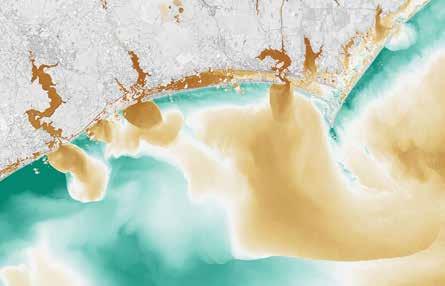

The study reports that because human and animal fecal genetic markers are often found in flood waters, it is commonly assumed wastewater sources, septic systems and livestock farms are responsible for spreading antibiotic-resistant bacteria and genetic material into the environment. However, no known studies have conclusively identified contaminant source points.
“Coastal North Carolina is a great case study area because there is a high concentration of swine farms and private septic systems, and coastal flooding caused by tropical storms is fairly common,” Nguyen said.
Three weeks after Hurricane Florence, Nguyen’s team collected 25 water samples from water bodies downstream of the swine farms in agricultural production areas in North Carolina, 23 of which contained the S. enterica bacteria.
“We analyzed free-floating genetic markers – chromosomes and plasmids – using high-fidelity whole-genome sequencing and found that S. enterica in the samples collected after Hurricane Florence were not from animals or manure,” Nguyen said.
The team genetically traced the bacteria’s origin to the many small local rivers and streams in the area –meaning that these pathogens have already established themselves in the natural environment.
22 cee.illinois.edu
Graduate student Yuqing Mao, left, and professor Helen Nguyen.
A NASA image containing visible and infrared data revealing the presence of dissolved organic matter – including potential antibiotic-resistant pathogens – in the waterways along coastal North Carolina after Hurricane Florence. Image courtesy NASA
Agricultural and human wastewater should not be the only sources considered when designing mitigation plans to prevent the spread of pathogenic bacteria after hurricanes.

Stillwell to lead translational research initiative for new tiny home community
“With climate change bringing warmer temperatures – in which bacteria thrive – and possibly larger and more frequent tropical storms, the importance of our findings needs to be realized by researchers and policymakers,” Nguyen said. “Agricultural and human wastewater should not be the only sources considered when designing mitigation plans to prevent the spread of pathogenic bacteria after hurricanes.”
Nguyen’s team plans to extend this research beyond coastal regions and is collaborating with other campus researchers to study the spread of pathogens from Canada goose feces in Illinois.
Researchers from the Carl R. Woese Institute for Genomic Biology (IGB), the Carle Illinois College of Medicine and the University of Florida also contributed to this study.
The IGB, The Grainger College of Engineering, the Allen Foundation and the EPA supported this study. i
A community of tiny homes for medically fragile, chronically homeless individuals will open in 20242025 in Urbana, with CEE Associate Professor Ashlynn Stillwell leading the effort to incorporate translational research from the University of Illinois Urbana-Champaign (UIUC) into the project.
Hope Village is being developed on an eight-acre plot of former farmland in north Urbana. The community of tiny homes will provide “hard to house” individuals access to health care and other supportive services in a neighborhood community atmosphere. It is a first-of-its-kind collaboration among Carle Health, Champaign County Health Care Consumers and UIUC.
“The university is excellent when it comes to the aspects of translational research – how do we take the fundamental research and the discoveries that we have at the University and get that out into the public sphere where it can really make a difference,” Stillwell said.
Much of the research to be incorporated is related to sustainability.
“I came to this through a lot of the work that my students and I have been doing in research with sustainable water and energy systems and how that relates to infrastructure,”

Stillwell said, “so in addition to the tiny homes aspect, we’re trying to do this as sustainably as possible.”
Some of the planned sustainability features include:
l Energy sustainability with solar panels with innovative microinverters and geothermal technology for space heating and air conditioning
l Water sustainability with low-flow fixtures and smart leak detection
l Landscape sustainability with onsite stormwater management and native plants
l Building sustainability with trauma-informed design, sustainable building materials and design for healthcare innovations
Trauma-informed design is an attempt to create a peaceful, calming atmosphere in recognition of the fact that many previously unhoused individuals have experienced trauma. i
Civil and Environmental Engineering Alumni Association—Summer 2024 23
Architect’s rendering of Hope Village courtesy of Architectural Expressions. For more information about Hope Village, visit hopevillagecommunities.org/.
Civil and Environmental Engineering Alumni Association—Summer 2024 23
Ashlynn Stillwell
2023 Turkey earthquake holds lessons for the future
The earthquake that devastated Turkey and Syria in February 2023 killed at least 59,259 people and caused economic damage estimated at more than $160 billion. The earthquake was surprisingly strong given the historical seismicity of the region, and the rupture it caused was larger than that of any major earthquake documented on the East Anatolian Fault in several hundred years. Now a recently published paper by earthquake researchers co-led by CEE Associate Professor Ahmed Elbanna, sheds light on the strength and devastation of the earthquake and gives insight into how to prepare better for future quakes.
“It is critical to understand the mechanics of this damaging earthquake, how it started, why it grew that big, and what implications we can expect for the ground shaking and potential damage to the built environment in the U.S. and worldwide,” Elbanna said. “There are multiple similarities between the tectonic setting in Southeast Turkey and
 Ahmed Elbanna
Ahmed Elbanna

California, and we expect the next big earthquake on the San Andreas fault to be of a comparable, or even a bit larger, magnitude than the earthquake in Turkey. There are also similar seismic vulnerabilities in the built environment in the seismically prone areas of the U.S. that could amplify the economic losses.”
In this paper, the researchers used data and physics-based models to answer some of the outstanding questions about the earthquake. The East Anatolian Fault is one of the best instrumented faults in the world with multiple seismic stations within a couple of kilometers close to the fault trace. This gave researchers an unprecedented opportunity to visualize the rupture propagation and apply principles from fracture mechanics to understand its characteristics.
“Surprisingly, we did find that the rupture in this earthquake started in a quite atypical way: It initiated on a
previously unmapped fault, the Narli fault, and quickly transitioned to a supershear speed,” Elbanna said. “Usually earthquakes propagate slower than the shear wave speed in the rocks. However, occasionally they can exceed that speed. This is similar to an airplane exceeding the speed of sound in air and producing a sonic boom. So when an earthquake overruns the shear waves it produces, it becomes a supershear event, and it produces damaging Mach cones, similar to what an airplane will generate.”
The full paper was published December 5, 2023, in Nature-Communications Earth and Environment. CEE alumnus Mohamed Abdelmeguid (PhD 23) and CEE alumnus and current Ph.D. student Chunhui Zhao (MS 21) are co-first authors. Authors also include Professor Ares Rosakis (Caltech) a recipient of an UIUC Honorary doctorate (2023). i
24 cee.illinois.edu
Landslide due to earthquake in Turkey in February 23. Photo: istockphoto.com/ MahmutSonmez
Innovative AI-driven framework with flexible biosensors aims to combat worker heat stress
Assistant Professor Houtan Jebelli has been awarded a grant by the Centers for Disease Control and Prevention to spearhead a pioneering project addressing worker heat stress through the fusion of Artificial Intelligence (AI) and advanced flexible wearable sensors.
The project introduces a revolutionary heat stress monitoring framework, primarily focused on workers in heat-vulnerable industries such as construction, firefighting and agriculture. The essence of this innovation lies in its ability to predict heatstress exposure through a sophisticated blend of machine learning algorithms and cutting-edge flexible biosensors. These biosensors are designed to be non-invasive, wireless and highly sensitive to physiological changes, offering real-time insights into workers' health.
The proposed system sets itself apart by employing advanced machine learning algorithms capable of analyzing complex physiological and environmental data. These algorithms are designed to predict potential heat stress incidents by continuously monitoring and interpreting signals such as blood flow, skin hydration, skin and core temperatures, and cardiac activity.
Central to this technology are the flexible biosensors, which represent a major technological leap. The sen-
sors are envisioned to be non-invasive, lightweight and unobtrusive, allowing for continuous monitoring without hindering the wearer's movement or comfort. They will be capable of transmitting real-time data wirelessly, enabling immediate analysis and feedback.
One of the key challenges in existing heat stress monitoring methods is their reliance on broad environmental or working conditions, often overlooking individual physiological differences. Jebelli's project addresses this by providing a tailored monitoring solution. The AI component of the system will not only process real-time data but also learn from it, adapting to each worker's unique physiological profile. This level of personalization ensures that the monitoring is precise, timely and more effective in preventing heatrelated illnesses.
The testing protocol will involve controlled laboratory experiments to fine-tune the biosensors and AI algorithms. These tests are crucial for calibrating the system to accurately interpret physiological data and environmental factors. Following laboratory validation, the system will undergo field testing in real-world job sites. This phase is critical for assessing the robustness and practicality of the wearable sensors and AI framework in diverse working conditions.

Field tests will also provide valuable insights into the user experience and the system's integration into daily work routines.
The potential impact of the system is vast, Jebelli said. By providing early warning of heat stress, it can drastically reduce the risk of severe injuries and fatalities among workers. Furthermore, the technology has implications beyond immediate safety; it could lead to better work scheduling, improved working conditions and overall enhanced worker wellbeing. The success of this project could pave the way for similar technologies in other high-risk industries. The application of AI and flexible biosensors could be extended to monitor other occupational hazards, such as exposure to toxic substances or extreme fatigue, revolutionizing worker safety across various sectors.
“By integrating AI and flexible biosensors, this technology promises to deliver a more nuanced, accurate and timely approach to monitoring and preventing heat stress among workers,” Jebelli said. “It holds the promise of not only safeguarding workers in high-risk industries but also of setting a new standard in occupational health monitoring.” i
Civil and Environmental Engineering Alumni Association—Summer 2024 25
Houtan Jebelli holds a prototype of the flexible, wireless biosensors his research team designed for monitoring heat stress in workers.

Lehe wins CAREER award to study public transportation pricing
Assistant Professor Lewis Lehe has won a CAREER award from the National Science Foundation to study public transportation pricing.
Lehe’s CAREER project will inform common policy choices about whether to charge prices for the use of certain transportation services and facilities, such as metering parking or fare-free transit. The research will extend models of road and transit systems to account for special considerations that arise when prices are added or removed, for example the difference in bus boarding times with and without fares. The project will also consider equity factors through simulations calibrated to represent real communities, to capture policy impacts across sociodemographic groups and income levels.
Researchers will also conduct surveys to understand people's attitudes toward alternative pricing strategies and will illuminate how people think about the fairness of transportation pricing.
In addition, educational tasks complementary to the research will give civil engineering students experience in thinking rigorously about implementing real policies and make knowledge of transportation engineering more accessible. The research, education and outreach plans are tightly integrated, to further disseminate the impacts through active and interactive learning opportunities to broaden participation in STEM.

Lehe joined the CEE at Illinois faculty in 2018. He received his B.Phil. in Mathematics-Economics from the University of Pittsburgh, an M.A. in Transport Economics from the University of Leeds, and M.S. and Ph.D. degrees from the University of California, Berkeley. His research focuses on transportation pricing, urban traffic, traffic theory and transportation economics. i
CAREER awards, administered under the Faculty Early Career Development Program, are the National Science Foundation’s most prestigious form of support and recognition for junior faculty who “exemplify the role of teacher-scholars through outstanding research, excellent education and the integration of education and research within the context of the missions of their organizations.”
26 cee.illinois.edu
Lewis Lehe
Brian Stauffer

Tessum wins CAREER award to
study environmental equity of decarbonization strategies
Assistant Professor Christopher
Tessum has won a CAREER award from the National Science Foundation to study the air quality and environmental equity implications of different decarbonization strategies.
“The U.S. and other nations are at the beginning of a major technological shift from a fossil fuel-based economy to one driven by non-climate-forcing energy generation,” Tessum said. “The speed and success of this technology shift, or ‘decarbonization,’ depend in part upon whether it is perceived to be implemented equitably with benefits that accrue broadly across society.”
A major way that energy generation intersects with equity is through ambient air pollution, Tessum said. Ambient air pollution is one of the largest causes of death in the U.S. and globally, with health burdens that are distributed inequitably on both regional and international scales.
Minimal research has been conducted into the air quality and environmental equity implications of different decarbonization strategies.
Furthermore, current integrated assessment models, which are used to develop decarbonization strategies, have minimal support for air quality assessment and are not well-suited to quantify environmental inequity.
Tessum’s project will develop a new modeling framework for integrated assessment of climate, air quality and environmental equity impacts of policy scenarios, and apply the framework in the analysis and evaluation of climate policy.
The goal of the research is greatly improved understanding of the co-benefits and dis-benefits of decarbonization policy scenarios, especially as related to environmental equity, both within the U.S. and internationally. It also targets improved understanding of effective methods for educating the general public on climate science and policy.
The open-source computational tools to be created aim to facilitate the calculation of air quality co-benefits and related equity by policymakers, sustainability scientists and others. This goal is to result in a stronger

technical grounding for decarbonization policy. In addition, because the perception of equity is critical to successful decarbonization, the identification of strategies that mitigate environmental inequity – and the development of educational tools to broadly communicate the benefits of those policies – will contribute to the fight against climate change overall.
Tessum joined the CEE department in January 2020. His research focuses on modeling air pollution and its health impacts, quantifying inequities in the distribution of those impacts, and proposing and testing solutions. He studies the relationships between emissions, the human activities that cause them, and the resulting health impacts, and he develops modeling capabilities to enable these types of analyses. i
Civil and Environmental Engineering Alumni Association—Summer 2024 27
istockphoto.com/Artis777
Chris Tessum

GLCM students travel to Vietnam
Over winter break, students in the Global Leaders in Construction Management Program visited Hanoi and Ho Chi Minh City, Vietnam, where for almost two weeks they toured construction sites, visited industry partners and took in the country’s history and culture
By oliviA gruBisiCh
After an entire day of travel, GLCM touched down in Hanoi, exhausted but ready for the trip ahead. After all, the program and its director, CEE at Illinois Instructor E.J. Ignacio (PhD 24), are no strangers to arduous travel for the sake of civil engineering. Visiting new parts of the world plays an integral part in GLCM’s mission: to emphasize a global perspective on the construction industry through a balance of theory and practice. Recent destinations include Panama, Vienna and Rome.
And just like previous trips, students were in for a jam-packed time abroad. They hit the ground running with a city tour of Hanoi and kept full steam ahead the next day with a visit to the Vietnamese conglomerate,
VinGroup.
“We had the unique opportunity to coordinate with VinGroup, the largest conglomerate in Vietnam that focuses on technology, industry, real estate development, retail, healthcare and hospitality,” Ignacio said. “This provided access to a wide range of construction projects that we were able to visit.”
Connecting with VinGroup also gave students the opportunity to visit VinUniversity, a newly established college with burgeoning ties to UIUC and The Grainger College of Engineering. While there, GLCM met with other students and toured the facilities, hoping to promote further collaboration between the two institutions.
This experience, in addition to vis-
its with other construction sites and businesses, provided great perspective on the Vietnamese construction industry and caused students to reflect on their construction experience in the U.S.
“A lot of the students reflected on how grateful they are to have opportunities in the United States,” Ignacio said. “They found that several of the Vietnamese construction sites were less safe or lacked the traditional construction methods that we take for granted.”
Between their educational activities, students still found time to soak up the rich culture and history both Hanoi and Ho Chi Minh City had to offer. They sampled local cuisine, explored caves, took a boat ride to the Mekong Delta, went shopping at
28 cee.illinois.edu
Ha Long Bay
the Hanoi night market and so much more.
GLCM’s trip to Vietnam wouldn’t have been possible without their host, Asia-Pacific Academic. The administrative planning of Tina Dong and Sharon Jiang, and the in-person guidance from Zoe Gu, Yunpeng Cheng and Kiki Zou was invaluable, keeping the CEE students on track and setting them up for a successful trip.
On their last night abroad, everyone gathered for a farewell dinner in Ho Chi Minh City. Students laughed and reminisced about the sights they’d seen and challenges they’d



overcome, eager to take all they learned about global construction back to their studies in the States. More than this, though perhaps unbeknownst to them at the time, they were also taking with them memories and friendships to last a lifetime.
“I doubt the students will remember the all-nighters spent studying for one of my exams or group project submissions, but I have no doubt the memories of the trips, stories and jokes told during the two-week trip will have a lasting impression,” Ignacio said. “As GLCM Director, I am truly honored to provide them this opportunity.” i
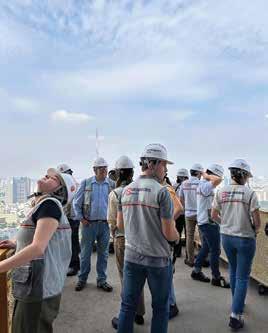
While abroad, students kept blogs of their daily acitivities. Read them here!
Civil and Environmental Engineering Alumni Association—Summer 2024 29
GLCM repping CEE at Illinois while visitng a VinGroup construction site.
Above: Group photo of GLCM in Động Thiên Cung Cave. Right: Scared of heights? Not GLCM! While visiting a BM Windows building site, they rode a hoist to the 32nd floor. Below: Scenes from the Hanoi night market. Photos on these pages by Keely Ashman and GLCM students.
CEE’s new Center for Secure Water (C4SW) will address water stresses current and future
The Department of Civil and Environmental Engineering has launched the Center for Secure Water (C4SW), a new initiative dedicated to pioneering innovative solutions in the water resources sector. The Center seeks to address both current challenges and future water needs while upholding core values of excellence, adaptability, equity and impact creation.
C4SW harnesses the collective expertise of transdisciplinary teams, combining deep domain expertise, science-based actionable knowledge, innovative engineering practices and products, ethical technology, socio-economic equitable principles and policies, and a systems approach to risk management. Through this comprehensive approach, it will foster the co-development of solutions inspired by user needs and preferences, ensuring that our efforts yield tangible and sustainable benefits for society.
The rising demand for water across various sectors, including agriculture, industry and energy produc-


The rising demand for water across various sectors, including agriculture, industry and energy production, coupled with a growing global population, is causing severe water stress on the global scale.
tion, coupled with a growing global population, is causing severe water stress on the global scale. Climate change further compounds these challenges, altering the water cycle and increasing the frequency and intensity of water-related hazards such as floods, droughts and degraded water supplies. These hazards pose threats to infrastructure, livelihoods and ecosystems, particularly impact-
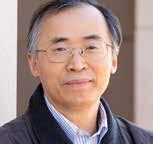

ing vulnerable and disadvantaged communities in North America and around the world.
Addressing these water-related challenges requires the development of innovative, smart and resilient water systems. The approach explores the creation of resilient infrastructure, adopts integrated and adaptive water management policies and practices, and incorporates ecosystem conservation and green infrastructure.
“At the Center for Secure Water, we are dedicated to developing novel solutions that ensure the sustainability and resilience of freshwater availability in coupled human-natural systems, safeguarding the wellbeing and prosperity of both current and future generations,” said CEE Department Head Ana Barros, C4SW’s Director.
Advancements in technology, including artificial intelligence, smart sensors, and new materials, offer promising opportunities for engineers to develop groundbreaking solutions to the water crisis. CEE Professor Ximing Cai, Deputy Director for C4SW, highlighted CEE's contribution in the space.
"The University of Illinois’ Department of Civil and Environmental Engineering possesses an unparalleled combination of intellectual depth and breadth, extensive experience and a proven track record of engineering excellence with a global
30 cee.illinois.edu
Ximing Cai
Ana Barros
Ana Pinheiro Privette

footprint," Cai said.
CEE's collaboration with the National Center for Supercomputing Applications further enhances its capabilities in developing transformative water sustainability solutions by tapping into cutting-edge computational resources.
Ana Pinheiro Privette joins CEE as the Managing Director for the Center for Secure Water, and the Director for Research Applications and New Research Initiatives in CEE. Before joining UIUC, Pinheiro Privette worked at Amazon Web Services as the Head of Sustainability for AWS Impact Computing, and the Global Lead for the Amazon Sustainability Data Initiative (ASDI). Prior to that, she led projects for the White House climate portfolio, including the Obama Climate Data Initiative (CDI) and the Partnership for Resilience and Preparedness (PREP), and worked as a research scientist at NASA and NOAA.
Pinheiro Privette underscored the importance of collaboration across sectors to catalyze the necessary change in the water space.
“We understand the critical need to establish strong partnerships across academia, industry, govern-

CEE possesses an unparalleled combination of intellectual depth and breadth, extensive experience and a proven track record of engineering excellence with a global footprint.
ment and civil society,” she said. “These collaborations are vital for codesigning and executing the most impactful solutions to tackle the challenges of our dynamic water future.”
The Center for Secure Water is actively engaging stakeholders in an extensive process to identify key challenges and guide the prioritization of initiatives. Additionally, they are seeking requests for collaboration from internal and external partners, fostering a network for innovative solutions in water resources. i
Vision
We envision a safe, resilient and sustainable world with equitable access and fair distribution of abundant, high-quality water to all people on the planet, balancing water needs for both environmental sustainability and socioeconomic development. We aspire to a future where water is not a limiting factor in the creation of healthy, prosperous societies, capable of thriving under all conceivable future climate conditions.
Mission
The mission of the Center for Secure Water (C4SW) is to establish the scientific, technological and engineering foundation to create novel, smart and resilient water systems, through active engagement in discovery and innovation. These systems are designed to adapt to changes in water resources availability under uncertain future climate and socioeconomic conditions, and actively respond to changes in future water regimes, water demand and extreme events.
Civil and Environmental Engineering Alumni Association—Summer 2024 31
istockphoto.com/Bartosz Hadyniak
2024 CEE Student Awards
A. Epstein Award in Civil Engineering
Emily Shao
Alan Zimmer Scholarship
Varun Vaid
Anna Lee and James T. P. Yao Scholarship
Parker Radler
Barry J. and Pauline G. Dempsey Transportation Scholarship
Daphne Eng
Bates and Rogers Scholarship
Simona Bodo
Bernard Delbert Murphy Scholarship in Civil Engineering
Brendan Graven, Kayla Wilson
Bob Zieba Memorial Scholarship
Desmond Stone
C.S. and Ruth Monnier Scholarship
Yuna Kim, Santiago Leyva
Caroll C. Wiley Travel Award
Yazmin Martinez
CEEAA Undergraduate Service Leadership Scholarship
Carson Schraer, Nina Trousdale
Charles E. Deleuw Scholarship
Greg Huang
Chicago Outer Belt Contractors Association Scholarship
Ethan Light
Class of 1943 Civil Engineering Award
Aditi Chockalingam
Clement C. Lee Outstanding Scholar Award in Honor of Houssam Mahmoud
Karara
Yatri Sutaria

Crawford, Murphy & Tilly Inc. Scholarship
Saliyah As-Salaam, Dominika Dynak
CRSI Education and Research Foundation Scholarship
Patrick Alonso
Dan and Mary Guill Engineering Scholarship
Nicholas Novak
Delores Wade Huber Scholarship
Andrew Ryu
DFI Educational Trust Charles J. Berkel Memorial Scholarship
Jonathan De La Rosa
Doland/Dural/Rayner/Chi Epsilon Award
Joseph Abi-Karam, Johanna Lin, Tara Reddy, Ella Spera
Donohue & Associates Scholarship
Aden Weiss
Doris I. and James L. Willmer Endowed Scholarship
Megan Otto
Duane Edward and Phyllis Ann Erickson Memorial Scholarship
Claire Corrigan, Camila Marden, Jocelyn Pytel
Earle J. Wheeler Scholarship
Luke Elston
Edward R. Healy Memorial Scholarship
Declan Colleran, Daisy Diaz
Eli W. Cohen-Thornton Tomasetti
Foundation Scholarship
Daniel Behbahani
Eric J. Kerestes Memorial Scholarship
Juliette Kim
ESCA Consultants Scholarship
Bruce Moore
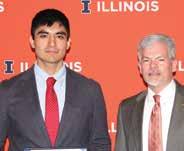
Engineering
Foster Research Scholarship
Jacob Gasior
Fred L. Gau Memorial Civil Engineering Scholarship
Charles Dolan, Ethan Kimbarovsky, Mana Takeda
George C. Eisenmayer and Ida Eisenmayer Scheve Scholarship
Natalie Carlisle
George L. Farnsworth Jr. Scholarship
Mayank Aggarwal, Cadyn Grafton
Glenn E. Hodges Civil Engineering Scholarship
Lizet Alvarez, Phillip Budzyna, Emmanuel Darkwa, Kassandra Estrella, Joseph Martorano, Daniel Moskal, Brandon Turck
Grant W. Shaw Memorial Scholarship
Carson Milligan
Harold R. Sandberg Scholarship
Matthew Ross, Gavin Ursetta
Harry K. and Carol A. Windland Scholarship in Memory of David A. Windland
Luis Castro, Katrina Padilla
Henry T. Heald Scholarship
Sarah Dzieza
Illinois Association of County Engineers Award
Austin Bunge, Sophia Donnellan, Luca Franceschina, Diego Garcia, Cayden Schroeder
Industry Advancement Foundation of Central Illinois Builders of the AGC Scholarship
Maximillian Saucedo
Ira O. Baker Award in Civil Engineering
Aaron Marszewski (first), John Sadek (second)

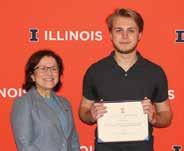 Above, left to right: Emily Shao, winner of the A. Epstein Award in Civil Engineering, with Tom Smiles of Epstein Global; Eduardo Mancera, winner of the Walter E. Hanson Graduate Study Award with Andy Canopy of Hanson Professional Services; Jeff Large of Crawford, Murphy &Tilly Inc., center, with Crawford, Murphy & Tilly Inc. Scholarship winners Saliyah As-Salaam and Dominika Dynak; Joseph C. and Marianne J. Geagea Civil and Environmental
Scholarship winner Maverik Davids, right, with Department Head Ana Barros.
Above, left to right: Emily Shao, winner of the A. Epstein Award in Civil Engineering, with Tom Smiles of Epstein Global; Eduardo Mancera, winner of the Walter E. Hanson Graduate Study Award with Andy Canopy of Hanson Professional Services; Jeff Large of Crawford, Murphy &Tilly Inc., center, with Crawford, Murphy & Tilly Inc. Scholarship winners Saliyah As-Salaam and Dominika Dynak; Joseph C. and Marianne J. Geagea Civil and Environmental
Scholarship winner Maverik Davids, right, with Department Head Ana Barros.
Ira O. Baker Memorial Scholarship
Madeleine Wahl
Jacobs Transportation Scholarship
Charles Rockow, Kevin Schneider
James P. Donnelly Memorial Scholarship
Daniel Behbahani
Jean D. and Michael W. Franke Scholarship
Alex Roskov
John B. Felmley Civil Engineering Scholarship
Jack Law, Benidel Ntumba, Fabian Padron
John O. Fooks and William D. Fooks Scholarship
Gabriel Dubowski
Joseph C. and Marianne J. Geagea Civil and Environmental Engineering Scholarship
Maverik Davids, Hailey Gordon, Rishi Patil
Julian Rueda Geotechnical Engineering Scholarship
Nathan Stutzman
Kay and John Briscoe Scholarship
Layne Jones, Max Lahnam
Klein and Hoffman Inc. Scholarship in Honor of Frank Klein
Chris Iliopoulos
Koch Scholarship in Civil and Environmental Engineering
Arannya Roy
Langan/Dennis J. Leary Memorial Scholarship
Aarón Pérez Araya
Leonard C. and Ruth E. Lindblom Undergraduate Scholarship
Anthony Gonzalez
Loreta and Silvio Corsetti Memorial Scholarship
Lucia Haymaker, Jack Marion
Louis A. Bacon Scholarship
Anthony Chen
Maren Somers Memorial Engineering Scholarship
Ciara West
Maude E. Eide Memorial Scholarship
Raj Patel, Siya Patel
Max Whitman Memorial Scholarship
Samuel Eberle
Moreland Herrin Scholarship
Drew Hecox


Norman Carlson Scholarship
Sam Mencimer
Ralph C. Hahn Civil and Environmental Engineering Scholarship
Julie Ferrer
Richard Jaccoud Scholarship
Sheikh Faysal, Alexander Gordon, Maxwell Harris, Sam Linares, Doga Mutis, Cam Schiavoni
RJN Foundation Civil Engineering Scholarship
Lucy Kleczewski
Rudolph Frizzi Geotechnical Scholarship
Sanjana Sivakumar
Shelby K. Willis Engineering Education Scholarship
Jessica Seo
Susan Douds Goertz and Jack L. Goertz Scholarship
Jenna Balaban
Walter E. Hanson Graduate Study Award
Eduardo Mancera
Wayne C. Teng Scholarship
Desiree Oliveros, Cambria Richards, Max Zhu
W.E. O’Neil Award
Yoonwha Jung
William A. Oliver Endowed Scholarship
Elise Slowinske
Professor Scott Olson, center, with the Ira O. Baker Award winners.
Aaron Marszewski, right, was the first place winner; John Sadek was the second place winner.
William C. Ackermann Sr. Civil Engineering Scholarship
Eddie Vercruysse
William E. Stallman Scholarship in Civil and Environmental Engineering
Jacob Futrell
William John MacKay Award
Steve Bae, Calvin Piemonte
William T. and Karen E. Arnold Scholarship
Brandon Daniels
Wilson H. Tang CEE International Scholarship
Youlun Jiang
Wilson H. Tang CEE Risk, Reliability & Decision Analysis Scholarship
Jameson de Beaumont
YED Scholarship
Livia Bezati
Zerbee Scholarship
Dev Desai, Nicholas Musgrove, Parker Roeder
 Above, left to right: Professor John Popovics, center, with Duane Edward and Phyllis Ann Erickson Memorial Scholarship winners Camila Marden and Jocelyn Pytel; Eric J. Kerestes Memorial Scholarship winner Juliette Kim, center, with Bob and Carol Kerestes.
Above, left to right: Professor John Popovics, center, with Duane Edward and Phyllis Ann Erickson Memorial Scholarship winners Camila Marden and Jocelyn Pytel; Eric J. Kerestes Memorial Scholarship winner Juliette Kim, center, with Bob and Carol Kerestes.
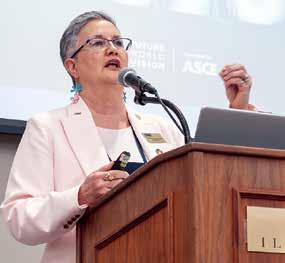


THE conference marks its 110th year
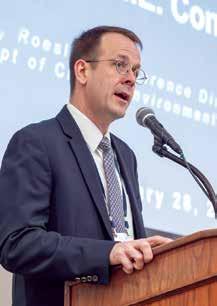

More than 1,500 transportation professionals gathered for the 110th Transportation and Highway Engineering (THE) Conference, held February 27-28, 2024, at the I Hotel & Conference Center in Champaign.
The conference has grown steadily since it was first presented in 1914. This year, a record-breaking number of registrants attended six breakout sessions.
Speakers included:
• Robert Molloy, Director of the Office of Highway Safety for the National Transportation Safety Board (NTSB) who spoke on “Advancing Highway Safety through NTSB Investigations and a Safe System Approach.”
• Marsia Geldert-Murphey, President of the American Society of Civil Engineers, who spoke on “Engineering Mobility for Smart Cities.”
• Craig Thompson, President of the American Association of State Highway and Transportation Officials and Secretary of the Wisconsin Department of Transportation, who presented on “The Future of Transportation Legislation and Funding –A National Perspective.”
“It is an honor to host this event on the University of Illinois campus for transportation professionals in the Midwest, to discuss recent transportation projects and innovations as well as collaborate on future challenges,” said conference director Professor Jeffery Roesler (BS 92, MS 94, PhD 98).
34 cee.illinois.edu
Photos by Jordan Ouellet
Omer Osman, Secretary of the Illinois Department of Transportation.
Marsia Geldert-Murphey, of Lochmuller Group, president of the American Society of Civil Engineers.
Professor Jeffery Roesler, THE conference director.
Cassaundra Rouse, Executive Director of the Illinois Tollway.
Craig Thompson, President of the American Association of State Highway and Transportation Officials and Secretary of the Wisconsin Department of Transportation.
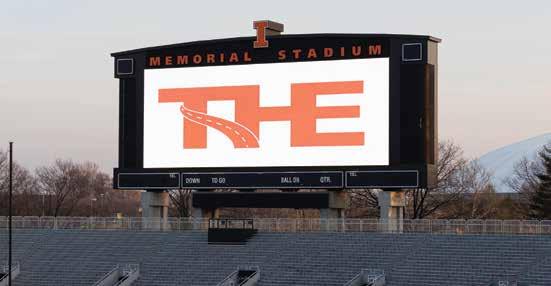




Civil and Environmental Engineering Alumni Association—Summer 2024 35
Winners of the student poster session Lama Aburfares (center) and Abhilash Vyas (right), CEE graduate students, pose with Kundayi Mugabe (BS 17, MS 22), a member of the conference planning committee.
Assistant Professor Ramez Hajj, left, and alumnus Jose Rivera Perez (MS 17, PhD 22) enjoy the fish fry at Legends on Green Street, a longstanding THE tradition.
The conference logo is displayed on the big screen at Memorial Stadium. Conference attendees enjoyed a mixer at the Colonnades Club in the stadium.
Robert Molloy, Director of the Office of Highway Safety, National Transportation Research Board.
Aaron Metzger (second from left), President of the Illinois Association of County Engineers (IACE), presented the IACE UIUC Student Scholarship to (left to right) CEE students Luca Franceschina, Diego Garcia, Sophia Donnellan and Cayden Schroeder. Also a recipient but not pictured was Austin Bunge.
New faculty
J. Riley Edwards

Assistant Professor J. Riley Edwards (MS 06, PhD 19) has been appointed to the department’s tenuretrack faculty. He is part of the Rail Transportation and Engineering Center (RailTEC). Edwards holds a Ph.D in Civil and Environmental Engineering and an M.S. in Civil Engineering, both from CEE at Illinois, and a B.E. in Civil Engineering from Vanderbilt University.
Since 2007, Edwards has held various positions within RailTEC, including Senior Research Scientist
Houtan Jebelli
Assistant Professor Houtan Jebelli joined the department in 2023 as a faculty member in the Construction Engineering and Management area.
He holds a Ph.D. in Civil Engineering from the University of Michigan, an M.S. in Structural Engineering from Sharif University of Technology, an M.S. in Construction Engineering and Management from the University of Nebraska-Lincoln, a third M.S. in Electrical Engineering and Computer Science with a focus on Machine Learning and Robotics from the University of Michigan and a B.S. from
Tehran Polytechnic University.
Jebelli’s research interests include advanced robotic systems for operational excellence in construction projects; advancing robotics and automation engineering pedagogy through the strategic integration of cutting-edge immersive technologies; next-generation wearable sensor technologies for predictive analytics in health and safety management; and optimized deployment of advanced safe human-robot interaction dynamics in complex and unstructured environments.
Did you know?
You can support CEE through gifts of stock and will avoid paying any capital gains tax on their appreciation.
Contact Steve Hall for details at stevhall@illinois.edu or 217-300-7830.
and Senior Lecturer (2019-2022) and Research Associate Professor (20222023).
Edwards’ research interests relate to the design and performance of railway infrastructure and its components for passenger, transit and freight applications, with a focus on materials and structural design. Additional research areas include the application of AI, DNNs and machine vision technology to railroad inspection tasks to improve rail safety and state of good repair.

36
DEPARTMENT NEWS
cee.illinois.edu
Houtan Jebelli
J. Riley Edwards
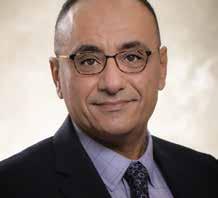
Professor Bassem Andrawes was named a Fellow by the American Society of Civil Engineers (ASCE). He is the Director of the Transportation Infrastructure Precast Innovation Center and is known for his pioneering work in the emerging application of shape memory alloys in civil infrastructure. ASCE fellows “have made celebrated contributions and developed creative solutions that change lives around the world.”
Ph.D. student Babak Asadi, a student of Assistant Professor Ramez Hajj, won the Data Science for Pavements Symposium Student Design Competition hosted by the Federal Highway Administration. He worked with Hajj and Professor Mani Golparvar on the project, which had the goal of predicting pavement condition index based on images.
Professor Ximing Cai has been recognized with the Warren A. Hall Medal by the Universities Council on Water Resources. The award honors exceptional accomplishments and distinction of an individual in the water resources field. It is given to those who have demonstrated a career-long commitment to exemplary
interdisciplinary scholarship and academic excellence in water resources.
Professor Praveen Kumar has been elected to the rank of Fellow in the American Association for the Advancement of Science. This honor is given to members whose “efforts on behalf of the advancement of science, or its applications, are scientifically or socially distinguished.” Kumar was cited “for pioneering the field of hydrocomplexity and for his groundbreaking contribution on the emergent behavior in multi-scale water, soil, climate and vegetation interactions in the context of critical zone science.”
CEE professors Youssef Hashash and Scott Olson (BS 94, MS 95, PhD 01) have won the 2024 Hogentogler Award from ASTM International. The award is given annually to the authors of an ASTM paper of outstanding merit on soil or rock. The winning paper, “A Multidirectional Cyclic Direct Simple Shear Device for Characterizing Dynamic Soil Behavior,” appeared in the ASTM Geotechnical Testing Journal. Co-authors include
Continued on the next page


Mariñas honored with CEE Impact Award
Professor Benito Mariñas was awarded a CEE Impact Award “for transformative leadership of the department.”
The awards are given to CEE faculty or alumni whose sustained efforts and dedication have significantly advanced the mission of the Department of Civil and Environmental Engineering at the University of Illinois Urbana-Champaign, elevated the department’s reputation, and enhanced the education of the department’s students with long-lasting impact.
Mariñas led the department from 2014-2020, first as Interim Head and then as Head. He led the campaign to raise funds for the new Civil and Environmental Engineering Building and the Kavita and Lalit Bahl Smart Bridge, completed in 2021.
Civil and Environmental Engineering Alumni Association—Summer 2024 37
Bassem Andrawes
Babak Asadi
CEE Department Head Ana Barros, left, presents the CEE Impact Award to former Department Head Benito Mariñas.
CEE students use data analysis to explore claims of racial bias in traffic camera use
A case study developed by CEE Assistant Professor Eleftheria Kontou and Industrial and Enterprise Systems Engineering Associate Teaching Professor Chrysafis Vogiatzis gives students an opportunity to work with data and evaluate challenges of bias in automated traffic law enforcement.
Titled “Racial Bias in Automated Traffic Law Enforcement and the Price of Unjustness,” the case study is based on a 2022 ProPublica article that claims “Chicago’s race-neutral traffic cameras ticket Black and Latino drivers the most.” Since Spring 2023, the case study has been used as part of the curriculum in two UIUC courses: Industrial Engineering “Analysis of Data” (IE300) and Civil and Environmental Engineering “Systems Engineering and Economics” (CEE201), where students in each class perform one of the study’s two parts.
In part one, students in IE300 collect pertinent socio-demographic data and conduct hypothesis testing to assess whether ProPublica’s claim is supported. Performing this task allows students to practice applying statistical analysis methods to evaluate the social components of automated traffic law enforcement.
In part two, CEE201 students formulate a shortest path problem that a driver in Chicago, worried about accumulating tickets, would need to
 Ria Kontou
Ria Kontou
solve to avoid some or all intersections with automated traffic cameras. Students then solve the problem they formulated to determine how much longer the driver’s trip will take from Chicago’s south side to O’Hare International Airport.
By performing the case study, students gain experience working with data to solve real world challenges related to transportation. The case is designed for courses in data analysis and statistical modeling that emphasize hypothesis testing and also applies to courses focused on optimization and mathematical modeling.
A paper detailing the case study is published in INFORMS Transactions on Education and can be read at the QR code.
Did you know?
If you are over 70½ years old, you can support CEE through a qualified charitable distribution from your IRA! You will pay zero tax on the distribution and positively impact our students.
Contact Steve Hall for details at stevhall@illinois.edu or 217-300-7830.
Continued from the previous page
CEE alumni Lopamudra Bhaumik (PhD 18) of Jacobs Engineering Group; Ozgun Numanoglu (MS 14, PhD 19) of Schnabel Engineering; and Alfonso A. Cerna-Diaz (MS 12, PhD 18) of AECOM. Additional co-authors are Cassandra J. Rutherford of Iowa State University and Thomas Weaver of the Office of Research, U.S. Nuclear Regulatory Commission.
Professor Rosa Espinosa Marzal was elected Vice-Chair of the American Chemical Society Division, Colloids and Surface Chemistry. Espinosa Marzal is the Donald Biggar Willett Faculty Scholar.
Assistant Professor X. Shelly Zhang (BS 12, MS 14) has won the Leonardo da Vinci Award from the American Society of Civil Engineering Engi-
 X. Shelly Zhang
X. Shelly Zhang
38
DEPARTMENT NEWS
cee.illinois.edu
38 cee.illinois.edu

neering Mechanics Institute “for important contributions to novel multi-physics topology optimization methods and fabrication strategies for highly multi-functional structures with programmable behaviors, and for translating practice.”
Zhang has also won the 20232024 Dean’s Award for Excellence in Research from The Grainger College of Engineering.
Assistant Professor Lei Zhao has been appointed a Fellow of the Center for Advanced Study for the 202425 academic year. One of the primary missions of the Center is to identify and support the most productive and innovative faculty at the University of Illinois Urbana-Champaign.
Zhao also was invited to help plan a Special Report on Climate Change and Cities for the Intergovernmental Panel on Climate Change (IPCC).The IPCC is the United Nations body for assessing the science related to climate change. Only approximately 10 experts from the United States were invited to participate.

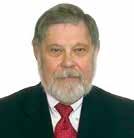

Emil C. Frein (BS 64), Col. USAF (Ret.), died September 25, 2022. He was 81. Frein earned a master of science degree in civil engineering from the University of New Hampshire in 1968. He was a Vietnam veteran who served 23 years in the U.S. Air Force. After military retirement, Frein and his family settled in Colorado, where they enjoyed all their outdoor activities of fishing, boating, hunting and camping. Frein was employed in the sporting goods industry for many years. He is survived by his wife, Betty, three children, four grandchildren and one greatgrandson.
Edward L. Murphree (PhD 67), Jr., died December 26, 2023, in Oakton, Va. Before coming to Illinois, Murphree had earned a B.S. in civil engineering from the University of Mississippi, an M.S. in civil engineering from the Massachusetts Institute of Technology and an M.S. in mathematics from the University of Mississippi. At Illinois, his Ph.D. adviser was Professor Steven J. Fenves. From 1964-1983, Murphree lectured in Civil Engineering, Industrial Engineering, Operational Research and Architecture on the UrbanaChampaign campus. From 19751985, Murphree was president of
Sage Systems Corporation, a small, Urbana-based consulting firm specializing in operations research and related activities. In 2013, he retired as Professor Emeritus, Department of Engineering Management & Systems Engineering, George Washington University. Until 2021, he continued to review papers for American Society of Civil Engineers journals.
Thomas J. Pfeiffer (BS 58) died Oct. 17, 2023. He was 86.
Wallace W. Sanders Jr. (MS 57, PhD 60), 90, died January 6, 2024, in Ames, Iowa. He was a Professor in the Department of Civil Engineering at Iowa State University for 34 years, retiring in 1998. At Iowa, he also served as Assistant and Associate Director of the Engineering Research Institute, Associate Dean of the College of Engineering, Director of the Iowa Space Grant Consortium and an Interim Assistant Vice Provost for Research and Graduate Students. He served on numerous professional and technical committees for professional societies including the American Society of Civil Engineers, the American Society for Engineering Education and the American Institute of Steel Construction (AISC). His multiple awards included the AISC Lifetime Achievement Award for Excellence in Engineering Education.
Civil and Environmental Engineering Alumni Association—Summer 2024 39 IN MEMORIAM
Wallace Sanders
Civil and Environmental Engineering Alumni Association—Summer 2024 39
Edward Murphree
Emil Frein
Lei Zhao

Catherine E. French (MS 80, PhD 84) was elected to the National Academy of Engineering. French is the CSE Distinguished Professor in the Department of Civil, Environmental and Geo-Engineering at the University of Minnesota, Minneapolis. The citation reads, “For design, safety and construction of structural concrete buildings and bridges.”
French was the first woman professor in civil engineering at the University of Minnesota in 1984. She has been honored by the American Society of Civil Engineers as a Distinguished Member (2018) and was named Minnesota Woman of the Year in 2017 by Women in Transportation Studies. French led the creation of the Multi-Axial Subassemblage Testing Laboratory in 2004 at the University of Minnesota. It was a first-of-its kind facility sponsored by the National Science Foundation to study earthquake engineering. Her research on reinforced and prestressed concrete structural systems led to new guidelines to improve public safety. She is a leader in building codes for structural concrete systems.

Neil Hawkins (MS 59, PhD 61) has been awarded the Building the Future Award from the American Concrete Institute. The citation reads, “For your strong commitment to strengthening our student scholarship program through proactive involvement and by stewarding donors and donations for that program.”
CEE alumna Angeli Jayme (MS 12, PhD 20), CEE Professor Imad Al-Qadi and CEE alumnus Egemen Okte (MS 18, PhD 22) received the K.B. Woods award from the Transportation Research Board for outstanding paper published in the field of design and construction of transportation facilities, for their paper entitled, “Environmental and Economic Efficiency of Stone-Matrix Asphalt with Surface Micro-Milling.”
Yoonhwa Jung (MS 20), a current CEE Ph.D. student working with

Michael E. Peterson (BS 74), left,
ment
Association
P. Barros
dinner in March. Peterson recently celebrated the 50th anniversary of his graduation from UIUC. He earned a B.S. in Civil Engineering with a primary concentration in Structural Design and a minor in Construction Management. His projects have included serving as project manager for the State of Illinois’ Capital Development Board on the construction of the Govenor James R. Thompson State of Illinois Building in downtown Chicago.
Professor Mani Golparvar (Ph.D. 10) is the recipient of the 2024 KoreanAmerican Construction Engineering and Project Management Association (KACEPMA)/HanmiGlobal Graduate Student Scholarship.

Xinchang Cathy Li (MS 19), a current Ph.D. student, has received the Linus Pauling Distinguished Postdoctoral Fellowship from the Department of Energy’s Pacific Northwest National Laboratory. Li’s adviser is Assistant Professor Lei Zhao.
40 cee.illinois.edu ALUMNI NEWS
with Depart-
Head Ana
at the CEE Alumni
awards
Catherine E. French (MS 80, PhD 84)
Yoonhwa Jung (MS 20)
Xinchang Cathy Li (MS 19)

Scott Trotter (BS 90), President of Trotter and Associates Inc., spoke to students in a Construction Engineering class in February 2024. Trotter and Associates is an Industry Partner of CEE at Illinois. For more information about the Industry Partners Program, visit cee.illinois.edu/corporate/ our-partners.
Kaitlin Mallouk (MS 09, PhD 16), an associate professor in the Department of Experiential Engineering Education at Rowan University, has received a National Science Foundation award. Her project, “Engineering Persistence: A Support System for Low Income Students to Catalyze Diversity and Success,” aims to provide scholarships for low-income, high-achieving students to pursue a degree in engineering at Rowan.
CEE alumnus Daniel W. Mueller (MS 23) received the William W. Millar Award from the Transportation Research Board for best paper dealing with public transportation for his work, co-authored with CEE alumni Marcus Dersch (BS 09, MS 10, PhD 22), Arthur de Olivera Lima (MS 17), and J. Riley Edwards (MS 06, PhD 19) entitled, “Development of a Real Time Wheel Load Quantification System for the Transit Environment.”
Spellmon named Grainger Distinguished Alum

Lt. Gen. Scott A. Spellmon was awarded a 2024 Grainger College of Engineering Alumni Award for Distinguished Service, “For his leadership as commanding general of the U.S. Army Corps of Engineers providing critical services such as disaster response, flood control, energy production, and land and water management; for leadership in the U.S. Army ensuring state-of-the-art combat support for U.S. soldiers; and for service through a lifetime career in the U.S. military.”
Spellmon was a 2023 Distinguished Alumnus of CEE at Illinois.

ALUMNI NEWS Civil and Environmental Engineering Alumni Association—Summer 2024 41
William F. Baker (MS 80) was interviewed for The Grainger College of Engineering magazine, Limitless. Baker’s buttressed core design enabled the world’s tallest building, the Burj Khalifa in Dubai, to exceed the previous record by more than 1,000 feet. To read his Q-and-A in Limitless, follow the QR code.
Scott A. Spellmon (MS 97)
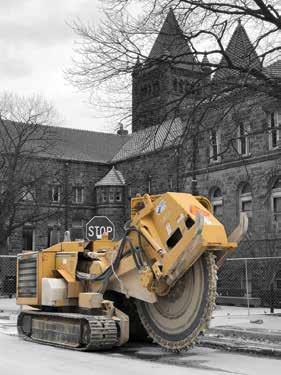
Earthquakes next to you: how to avoid threatening neighbors
By Nikita Bondarenko, Ph.D. student
Cutting the Way Through
by Jordan Ouellet, Ph.D. student
Pavements are meant to outlast generations. Without probably knowing, motorists commuting on Central Avenue in Urbana, Ill., have been riding on the very same concrete pavement cast in August of 1919.
A hundred years ago, pavements were designed mostly for durability. Today’s engineers are faced with renewed objectives in a world where rideability, rapidity, economy and sustainability are all required. Pavement design and engineering principles have radically shifted, with many well-established notions only good for demolition. Advancements in material science, construction equipment and design theory, allow emerging materials to cut through the doors of
our laboratory to be implemented in the field successfully. This is the case of roller-compacted concrete, a cement-based material that uses aggregate interlocking theory used for soils coupled with paving and compaction methods used for asphalt. This newer type of pavement can achieve target strengths after only a few days and requires up to 20% less cement powder, responsible for cost and global warming. After serving through the design lifespan, pavement deconstruction is facilitated with a track-mounted trencher as pictured on Wright Street by Altgeld Hall in Urbana. Nevertheless, constructing them better requires challenging ideas and principles by never letting them set in concrete.

Addressing the climate change challenge may involve the subsurface injection of carbon dioxide, even in your local area. For instance, near the UIUC campus in Decatur, millions of tons of this greenhouse gas are injected into the ground, leading to microearthquakes that typically go unnoticed. However, as the injection continues, there is a growing risk of more significant earthquakes. To mitigate potential adverse effects, a state-of-the-art numerical model has been developed to forecast the subsurface processes during injection. This tool plays a crucial role in preventing unintended interactions with subterranean earthbors, ensuring our safety.

Paving the Future with Sustainable Stone-matrix Asphalt
by Javier J. García Mainieri (MS 20, current Ph.D. student)
Roads connect us to opportunity. Be it for love, personal ambitions, or professional development, we hit the pavement daily. Transportation infrastructure is expensive, and producing the materials needed to build it impacts the environment.
Stone-matrix asphalt (SMA) is a type of paving material that is durable but is currently not widely used because of its cost and long-haul distances for the rock aggregates required to make it. With our research we want to prove that local aggregates that meet less stringent quality requirements may be used in SMA, if we rethink its design.
We have designed SMA in the lab and proved that it has excellent performance potential. We can design local-aggregate structures that interlock and resist rutting. A step is pending to give confidence to the Illinois Department of Transportation: A full-scale test! In the photo, an experimental 450ft-long lane is shown. Test sections will be loaded with an accelerated loading system. With the results, it will be possible to carry out life cycle cost and environmental analyses that will determine how SMA shall be used.
We will ride on sustainable surfaces that were efficiently built, saving tax-payers dollars. In the future, we will ride on sustainable SMA!
42 cee.illinois.edu

HONORABLE MENTION, IMAGE OF RESEARCH CONTEST
The Invisible Architecture: Decoding Concrete’s Micro-World
by Bayezid Baten, Ph.D. student
On these pages are submissions by CEE students to the Image of Research competition, held each year by the Graduate College.
Within the confines of this striking image, captured through the lens of a Scanning Electron Microscope, lies a world often unseen yet foundational to our modern existence. This is not a distant alien landscape, nor the surface of a remote asteroid. It is, in fact, a glimpse into the secret life of high-performance concrete – a material so ubiquitous in our lives, yet so rich in hidden detail and complexity. What we perceive as solid and impenetrable at our scale morphs into a complex network of voids and particles, a testament to the intricate architecture hidden within. The textures are diverse: some areas are rugged and pitted, reminiscent of a weathered mountain face, while others appear smooth and polished, like the surface of a tranquil lake. This disparity illustrates the complex interactions occurring at the micro level, where chemical processes and physical forces converge to define the very essence of this material. My research delves into this unseen world, exploring how alterations in material composition transform this microstructure, and seeking to optimize the performance at the microscale for superior performance at the macroscale which testifies its incredible strength, resilience and durability.
Civil and Environmental Engineering Alumni Association—Summer 2024 43

NONPROFIT ORGANIZATION U.S. POSTAGE PAID CHAMPAIGN, IL PERMIT NO. 453 Department of Civil and Environmental Engineering The Grainger College of Engineering University of Illinois Urbana-Champaign Newmark Civil Engineering Laboratory MC-250 205 North Mathews Avenue Urbana, Illinois 61801














 By AnA BArros, nAE
DonAlD BiggAr WillE tt ChAir in EnginEEring AnD hEAD
By AnA BArros, nAE
DonAlD BiggAr WillE tt ChAir in EnginEEring AnD hEAD
 By DAnA B. MEhlMAn (BS 99, MS 01) PrEsiDEnt-ElEC t, CEE AluMni AssoCiAtion BoArD of DirEC tors
By DAnA B. MEhlMAn (BS 99, MS 01) PrEsiDEnt-ElEC t, CEE AluMni AssoCiAtion BoArD of DirEC tors





























 Ahmed Elbanna
Ahmed Elbanna



















 Above, left to right: Emily Shao, winner of the A. Epstein Award in Civil Engineering, with Tom Smiles of Epstein Global; Eduardo Mancera, winner of the Walter E. Hanson Graduate Study Award with Andy Canopy of Hanson Professional Services; Jeff Large of Crawford, Murphy &Tilly Inc., center, with Crawford, Murphy & Tilly Inc. Scholarship winners Saliyah As-Salaam and Dominika Dynak; Joseph C. and Marianne J. Geagea Civil and Environmental
Scholarship winner Maverik Davids, right, with Department Head Ana Barros.
Above, left to right: Emily Shao, winner of the A. Epstein Award in Civil Engineering, with Tom Smiles of Epstein Global; Eduardo Mancera, winner of the Walter E. Hanson Graduate Study Award with Andy Canopy of Hanson Professional Services; Jeff Large of Crawford, Murphy &Tilly Inc., center, with Crawford, Murphy & Tilly Inc. Scholarship winners Saliyah As-Salaam and Dominika Dynak; Joseph C. and Marianne J. Geagea Civil and Environmental
Scholarship winner Maverik Davids, right, with Department Head Ana Barros.


 Above, left to right: Professor John Popovics, center, with Duane Edward and Phyllis Ann Erickson Memorial Scholarship winners Camila Marden and Jocelyn Pytel; Eric J. Kerestes Memorial Scholarship winner Juliette Kim, center, with Bob and Carol Kerestes.
Above, left to right: Professor John Popovics, center, with Duane Edward and Phyllis Ann Erickson Memorial Scholarship winners Camila Marden and Jocelyn Pytel; Eric J. Kerestes Memorial Scholarship winner Juliette Kim, center, with Bob and Carol Kerestes.















 Ria Kontou
Ria Kontou
 X. Shelly Zhang
X. Shelly Zhang















